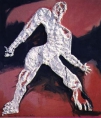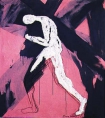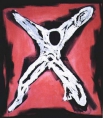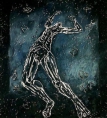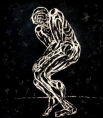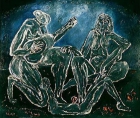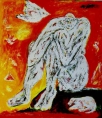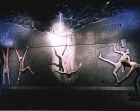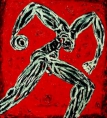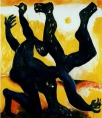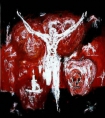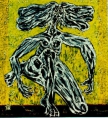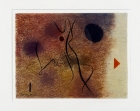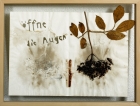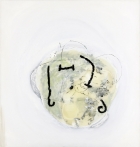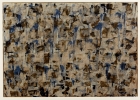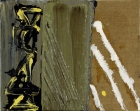
Artist | Eduardo DaRosa
https://www.artist-info.com/artist/Eduardo-DaRosa
Exhibitions (selection)
Exhibitions (selection)
1998 - 99 Traveling Exhibition: Museum of San Miguel de Allende, Qto, México - University Ibero Mexico, Léon, Guanajuato, México - Museo de la Ciudad de Querétaro, Qto, México - Museo de la Ciudad de Léon, Guanajuato, México
1998 T. Curtsnock Fine Arts, Miami, FL
1997 Museum of Art, Fort Lauderdale, FL
1998 Museo de la Ciudad de Querétaro, Qto, México
1998 Museo de la Ciudad de Léon, Guanajuato, México
1998 South FL Art Center, Lucky 13, Miami Beach, FL
1998 T. Curtsnock Fine Arts, Miami, FL
1997 Museum of Art, Fort Lauderdale, FL
1997 T. Curtsnock Fine Arts, Miami, FL
1996 The Lowe Gallery, Atlanta, Georgia
1996 Margulies Taplin Gallery, Miami, FL
1996 Art and Culture Centre of Hollywood, FL
1996 South Dakota State University Gallery
1996 HEIM Gallery of Art, Fisher Isle, FL
1995 Museum of Art, Ft. Lauderdale, 34th Annual Hortt Exhibition, Best In Show, Curated by Karen Wilkin, NYC Art Critic
1995 Kunstverein Gallery Pikanta, Leipzig, Germany;
Becks +4 Inaugural Exhibition, Curated by Becks +4
Victoria Galleries, Coral Gables, FL
1994 H. RLyons Gallery, Delrey Beach, FL;
1994 Ritter Gallery, Florida Atlantic University, Boca Raton, FL
1993 Moira Galeria de Arte, Lisbon, Portugal ;
1993 14th Chicago International Art Fair, Chicago IL;
1993 Museum of Art, Ft. Lauderdale, 35th Annual Hortt Exhibition;
1993 Miami Dade Community College - North Campus, FL
1992 Museum of Art, Ft. Lauderdale, 34th Annual Hortt Exhibition, Best In Show Curated by Kathleen Monaghan, Curator Whitney Museum of Art
1992 Miami International Art Fair, FL;
1992 Mido Gallery, Clearwater, FL;
About the work
About the work
THE PASSIONATE FIGURE - THE ART OF EDUARDO DA ROSA
The first time I saw a painting by Eduardo da Rosa was in 1992 at the big, open, juried exhibition of South Florida artists, the Hortt Competition, held every September at the Museum of Art. I knew immediately that I was in the presence of a major figure, one who transcended local significance. It seemed as if the New-Expressionist movement that had swept the international art scene in the late seventies had returned and was now producing important results. Da Rosa's "Who Killed Jean-Michel?" won the Best In Show award that year and the Museum acquired the picture for its permanent collection. His work was selected again for inclusion in the Hortt the following year and in 1995 he again won the Best In Show award for the "We Are All Cain's Children" making him the only artist in recent years to win this distinction twice.
Da Rrarely do we get the feeling of relaxation and a studio situation which we find so frequently in Matisse. Most striking is the fresh and unexpected relation of silhouette to rectangle and a confrontational, directness of address. Always there is the idea of universal man, naked but without any special sexual emphasis. Always there is titanic passion and energy. Like Picasso, da Rosa is a sculptor/draughtsman par excellence. His color and textures can be daring and aggressive, but the picture is ultimately carried by a draughtsmanly idea. And it is natural enough that da Rosa sometimes turns to figure sculpture or combines sculpture with his painting. He is adept in both mediums and his sculptures are no less passioing. It should be noted though, that his sculptures have their own distinct proportions with massive legs and hips and a diminished upper body.
The human figure in the context of post-war painterly abstraction first appeared in the work of Jackson Pollock, specifically in his black and white pictures of 1951. These show large sketchy figures which are more the product of gesture than nature. Pollock's example was soon followed by similar efforts by Willem de Kooning, Robert Goodnough and others. But these developments were submerged in the 60s by color field painting and minimalism, both of which were purely abstract. Only in the late 70s, with figures like Julian Schnabel, David Salle, Jean-Michel Basquiat, Georg Baselitz and the Italians, Sandro Chia, Francesco Clemente, Enzo Cucchi and Mimmo Paladino did post-painterly figuration gain center stage undeet despite occasional successes, this tendency did not produce a major figure, a representative to match Pollock. A member of the New New group of painters, Lucy Baker did a brilliant series of the gestural figurative works in the middle 80s, but these remained an isolated phenomena, a lone realization of New-Expressionism's potential. With his work of the early 90s, da Rosa took his place beside her. What is more, neo-figuration is far more central to da Rosa's art than it is to Baker's.
Da Rosa was born in the town of Ponte do Sor in Alentejo, Portugal, that province which has been the birth place of so many artists and writers. His father, the owner of a small factory, was a highly cultured man who instilled in him the love of the arts. As a young man da Rosa moved to Lisbon and quickly fell in with a group of artists and writers. Firsthis study of painting. But the year was 1958 and Portugal was under the dictatorship of Salazar. Da Rosa found the atmosphere of the Society hyper conservative and stultifying. He soon left and in 1960 he was able to visit Paris for four months. Now committed to painting and the visual arts, his idol was Picasso even though his temperament led him more to German Expressionism especially the Blaue Reiter group and the work of Franz Marc.
Unable to secure a living in Paris, da Rosa moved to Germany, settling in Düsseldorf for several years. Here it was that he met Isabel Oliveira, who was to become his life's companion and champion. Da Rosa likes to travel and he visited many places in Europe at this time. Also he applied to enter Canada as a resident and, in 1962, after first moving to Brazil, he first went to Montreal, but soon moved on to Toronto. Here he briefly attended the Three Schools of Art and had his first one-man exhibition in 1966 at a bookstore gallery. After that he was represented by Roza Mezei of the R.M. Gallery for several years. He continued to travel extensively vising California, New York, and other places in the United States and Canada. In 1969-70 he spent a year in Mexico, first in San Miguel de Allende and then in Mexico City. It was during his stay in Mexico City that da Rosa had a "breakthrough" experience, as he puts it, watching David Siqueiros working on the huge mural "The March of Humankind Towards the Cosmos". Da Rosa had been drawn to the human being as his subject matter ever since he began to paint, but Siqueiro's work challenged him by its grand ambition and prompted him to focus on the figure more exclusively.
Da Rosa was admitted for residence in the Unitedfamiliar. Between 1988-91 his pictures became larger and underwent an eruptive, formative development with the series "American Dream", 1989; "Urban Realities", 1990; and a huge 15,5x28 ft. magnum opus, "Joseph Beuys Sweeps Up Berlin", 1991, which showed over life size figures both in painted relief and three dimensions climbing over and gestulating before a wall. The latter work extends some nine feet into the viewers space. (Da Rosa later removed the pieces in the round because he found that the painting and relief were more effective by themselves).
In 1991 he began to realize his figures with heavy applications of white acrylic paste instead of the vivid flesh tones he previously favored. This made the figures seem skeletal and more abstract. They now loomthem more boldly. This last group of pictures which are featured in this exhibition, are da Rosa's most mature and personal works so far. He has said that the large chromatic skies of South Florida have influenced both his scale and his color. It may seem contradictory that Miami has provided the environment for the flowering of such a raw northern expressionist vision. But in this da Rosa is more the rule than the exception. Expressionism characterizes many of South Florida's leading figures: da Rosa, Carlos Alfonso, Arturo Rodriguez, José Bedia and Norman Liebman. They seem to be reacting against the sunny idyllicism of the area. In any event, da Rosa is one of the most exciting artists working anywhere today. He applies the European cultural tradition with a contemporary urgency. He offers grandness and pathos without sentimentality. His is a fully modern humanism with an eternal appeal.
Text by Dr. Kenworth W. Moffett
Executive Director, Museum of Art, Ft. Lauderdale, FL
Bibliography
Bibliography
1998 The Miami Herald, Armando Alvarez Bravo, Aug.
1997 "La Figura Apasionada"The Miami Herald, Armando Alvarez Bravo, May.
1996 Latin Painters, Glenn Harper, The Journal Constitution, Atlanta, Feb. 96
1995 "Hortt Exhibition is History Lesson in 20th Century styles" The Eastsider,
1995 "Pintura a Partier de la Leccion de Lombok, El Nuevo Herald, Galeria Pg. 4-D
1993 Symbols & Allegories, August, Catalogue
1993 Latin American Art Magazine, Prof. Carol Damian Pg. 74
1992 Hortt Exhibition High on Humanity, Miami Herald, Elisa Turner, Sept.13
1992 Arts & Leisure, Sun Sentinel, Sept. 15., Roger Hurlburt
1992 Art With Uneasiness, Palm Beach Post, Sept. 18th, Gary Schwau
1992 La Vida en Da Rosa, El Nuevo Herald, Aug. 1, Juan Carlos Perez
1991 The Post, Forum, "Holocaust Series Seeths With Human Emotion" June, pg 14
1989 "Portuguese paints the holocaust" Post Mordem, Dec.
Internet
Internet
e-mail: mail@darosa.com
Homepage of Eduardo DaRosa
 offers / Requests offers / Requests  |
About this service |
|---|
 Exhibition Announcements Exhibition Announcements  |
About this service |
|---|
 Visualization |
Learn more about this service | ||
|---|---|---|---|

Interested in discovering more of this artist's networks?
3 easy steps: Register, buy a package for a visualization, select the artist.
See examples how visualization looks like for an artist, a curator, or an exhibition place: Gallery, museum, non-profit place, or collector.

Exhibition History

|
SUMMARY based on artist-info records. More details and Visualizing Art Networks on demand. Venue types: Gallery / Museum / Non-Profit / Collector |
||||||||||||
| Exhibitions in artist-info | 2 (S 1/ G 1) |
Did show together with - Top 5 of 16 artists (no. of shows) - all shows - Top 100
|
||||||||||
| Exhibitions by type | 2: 2 / 0 / 0 / 0 | |||||||||||
| Venues by type | 2: 2 / 0 / 0 / 0 | |||||||||||
| Curators | 0 | |||||||||||
| artist-info records | Oct 1997 - May 1998 | |||||||||||
|
Countries - Top 1 of 1 United States (2) |
Cities 1 - Top of 1 Miami (2) |
Venues (no. of shows )
Top 2 of 2
|
||||||||||
|
Curators (no. of shows)
Top 0 of 0 |
| Isabel Oliveira | S | Mar 1998 - May 1998 | North Miami | (1) | +0 | |
| T. Curtsnoc Fine Arts | G | Oct 1997 - Oct 1997 | Miami | (8) | +0 | |
| Keep reading |











